Multi-Scenario Simulation and Trade-Off Analysis of Ecological Service Value in the Manas River Basin Based on Land Use Optimization in China
Abstract
:1. Introduction
2. Material and Methods
2.1. Overview of the Study Area
2.2. Data Ssources
2.3. Research Methods
2.3.1. GMOP–PLUS Model
Optimization of the LULC Structure Using the GMOP Model
- (a)
- Multi-scenario settings
- (b)
- Constraint setting
- (1)
- Total land
- (2)
- Population
- (3)
- Farmland
- (4)
- Woodland
- (5)
- Grassland
- (6)
- Water area
- (7)
- Construction land
- (8)
- Unused land
- (9)
- ESV
- (10)
- Model self-constraint
Optimization of the LULC Spatial Structure Using the PLUS Model
- (1)
- Suitability probability calculation
- (2)
- Neighborhood weight setting
- (3)
- Adaptive inertial competition mechanism
- (4)
- Random patch generation parameter settings
- (5)
- Transition matrix and final land development probability calculation
- (a)
- PLUS model input settings
- (b)
- Accuracy verification
2.3.2. ESV
Revision Based on Food Prices
Biomass-Based Revision
ESV Calculation
Sensitivity Analysis of ESV
2.3.3. Spatial Autocorrelation Analysis
3. Results
3.1. Spatial and Temporal Changes in LULC in the Manas River Basin
3.2. Temporal Changes in ESV in the Manas River Basin
3.3. Spatial Changes in ESV in the Manas River Basin
3.4. Sensitivity Analysis of the ESV
3.5. Ecosystem Service Trade-Offs and Synergies
4. Discussion
4.1. Response of ESV to Changes in LULC
4.2. LULC Coupled Model at the Basin Scale
4.3. Suggestions for a Basin Development Model Based on the ESV
4.4. Limitations and Future Research
5. Conclusions
- (1)
- The spatial LULC pattern in the Manas River Basin changed significantly. From 1980 to 2020, the areas of farmland, water area, and construction land tended to increase, whereas the areas of woodland, grassland, and unused land tended to decrease. From 2020 to 2030, under the ND scenario, the areas of farmland and grassland will generally remain stable, and the areas of woodland, water area, construction land, and unused land will increase or decrease; under the EPD scenario, a large amount of farmland and unused land will be converted into ecological land, where the area of ecological land will increase by 290.97 km2, but the expansion of construction land will be moderate; and under the EED scenario, the areas of grassland, water area, and construction land will tend to increase, where the area of construction land will reach 11.98%.
- (2)
- The ESV in the Manas River Basin showed an increasing trend of fluctuation. From 1980 to 2020, the ESV in the study area increased slightly from 237.27 × 108 CNY to 238.10 × 108 CNY. From 2020 to 2030, the ESV in the Manas River Basin will increase significantly, with increases of 14.37 × 108 CNY, 17.08 × 108 CNY, and 15.58 × 108 CNY under the ND, EPD, and EED scenarios, respectively. The ESV in the Manas River Basin will increase most under the EPD scenario, followed by the EED scenario and then the ND scenario. The spatial differences in the ESV in the Manas River Basin were significant, but the spatial distribution was relatively consistent over the years, with high distributions in the south and low distributions in the north.
- (3)
- From 1980 to 2020, the four individual ESV changes of supplying, regulating, supporting, and culture services in the Manas River Basin are shown as regulating services > supporting services > supplying services > cultural services. From 2020 to 2030, regulating services, supporting services, and cultural services will all tend to increase under the ND, EPD, and EED scenarios, but supplying services will increase or decrease under the three scenarios. From 1980 to 2030, in terms of primary ecosystem services, the ESVs for gas regulation, water conservation, and waste treatment will all tend to increase, whereas those for climate regulation, soil formation and protection, and biodiversity will decrease in a fluctuating manner.
- (4)
- In 2030, the trade-offs and synergies for various ecosystem services will be consistent in the Manas River Basin under the three scenarios with obvious significant synergistic effects, and the significant degree of synergetic relationship will be regulating services–cultural services > supplying services–supporting services >supporting services–cultural services > regulating services–supporting services > supplying services–regulating services > supplying services–cultural services. In terms of the spatial distribution, “low–low synergy” and “high–high synergy” clustering characteristics were obvious in the northern part of the basin and along the water system. Supplying services and the other three services mainly had “high–low trade-off” and “low–high trade-off” relationships in the plains and southern mountainous areas in the middle and north of the basin. The relationships comprising regulating services–supporting cultural, regulating services–cultural services, and supporting services–cultural services in this region were mainly scattered “low-low synergy” relationships, which were affected mainly by the distribution of ecological belts and human activities in the basin.
Author Contributions
Funding
Institutional Review Board Statement
Informed Consent Statement
Data Availability Statement
Conflicts of Interest
References
- Seppelt, R.; Dormann, C.F.; Eppink, F.V.; Lautenbach, S.; Schmidt, S. A quantitative review of ecosystem service studies: Approaches, shortcomings and the road ahead. J. Appl. Ecol. 2011, 48, 630–636. [Google Scholar] [CrossRef]
- Costanza, R.; de Groot, R.; Braat, L.; Kubiszewski, I.; Fioramonti, L.; Sutton, P.; Farber, S.; Grasso, M. Twenty years of ecosystem services: How far have we come and how far do we still need to go? Ecosyst. Serv. 2017, 28, 1–16. [Google Scholar] [CrossRef]
- Fu, Q.; Hou, Y.; Wang, B.; Bi, X.; Li, B.; Zhang, X. Scenario analysis of ecosystem service changes and interactions in a mountain-oasis-desert system: A case study in Altay Prefecture, China. Sci. Rep. 2018, 8, 12939. [Google Scholar] [CrossRef] [PubMed]
- Watson, L.; Straatsma, M.W.; Wanders, N.; Verstegen, J.A.; de Jong, S.M.; Karssenberg, D. Global ecosystem service values in climate class transitions. Environ. Res. Lett. 2020, 15, 024008. [Google Scholar] [CrossRef]
- Li, W.; Wang, L.; Yang, X.; Liang, T.; Zhang, Q.; Liao, X.; White, J.R.; Rinklebe, J. Interactive influences of meteorological and socioeconomic factors on ecosystem service values in a river basin with different geomorphic features. Sci. Total Environ. 2022, 829, 154595. [Google Scholar] [CrossRef]
- Solomon, N.; Segnon, A.C.; Birhane, E. Ecosystem Service Values Changes in Response to Land-Use/Land-Cover Dynamics in Dry Afromontane Forest in Northern Ethiopia. Int. J. Environ. Res. Public Health 2019, 16, 4653. [Google Scholar] [CrossRef] [Green Version]
- Liu, W.; Zhan, J.; Zhao, F.; Yan, H.; Zhang, F.; Wei, X. Impacts of urbanization-induced land-use changes on ecosystem services: A case study of the Pearl River Delta Metropolitan Region, China. Ecol. Indic. 2019, 98, 228–238. [Google Scholar] [CrossRef]
- Liao, M.L.; Chen, Y.; Wang, Y.J.; Lin, M.S. Study on the Coupling and Coordination Degree of High-Quality Economic Development and Ecological Environmet in Beijing-Tianjin-Hebei Region. Appl. Ecol. Environ. Res. 2019, 17, 11069–11083. [Google Scholar] [CrossRef]
- Gao, S.; Sun, H.; Zhao, L.; Wang, R.; Xu, M.; Cao, G. Dynamic assessment of island ecological environment sustainability under urbanization based on rough set, synthetic index and catastrophe progression analysis theories. Ocean Coast. Manag. 2019, 178, 104790. [Google Scholar] [CrossRef]
- Cai, J.; Li, X.; Liu, L.; Chen, Y.; Wang, X.; Lu, S. Coupling and coordinated development of new urbanization and agro-ecological environment in China. Sci. Total Environ. 2021, 776, 145837. [Google Scholar] [CrossRef]
- Huang, L.; He, C.; Wang, B. Study on the spatial changes concerning ecosystem services value in Lhasa River Basin, China. Environ. Sci. Pollut. Res. 2022, 29, 7827–7843. [Google Scholar] [CrossRef] [PubMed]
- Zhao, X.; Wang, J.; Su, J.; Sun, W. Ecosystem service value evaluation method in a complex ecological environment: A case study of Gansu Province, China. PLoS ONE 2021, 16, e0240272. [Google Scholar] [CrossRef]
- Yang, C.; Zhou, Y.; Chen, Y.; Wang, L. Ecosystem conservation and restoration through Nature-based Solutions. Earth Sci. Front. 2021, 28, 25–34. [Google Scholar] [CrossRef]
- Wang, W.; Jiao, L.; Jia, Q.; Liu, J.; Mao, W.; Xu, Z.; Li, W. Land use optimization modelling with ecological priority perspective for large-scale spatial planning. Sustain. Cities Soc. 2021, 65, 102575. [Google Scholar] [CrossRef]
- Li, C.; Wu, Y.; Gao, B.; Zheng, K.; Wu, Y.; Li, C. Multi-scenario simulation of ecosystem service value for optimization of land use in the Sichuan-Yunnan ecological barrier, China. Ecol. Indic. 2021, 132, 108328. [Google Scholar] [CrossRef]
- Riao, D.; Zhu, X.; Tong, Z.; Zhang, J.; Wang, Y. Study on Land Use/Cover Change and Ecosystem Services in Harbin, China. Sustainability 2020, 12, 6076. [Google Scholar] [CrossRef]
- Yuan, K.; Li, F.; Yang, H.; Wang, Y. The Influence of Land Use Change on Ecosystem Service Value in Shangzhou District. Int. J. Environ. Res. Public Health 2019, 16, 1321. [Google Scholar] [CrossRef] [Green Version]
- Gomes, E.; Inácio, M.; Bogdzevič, K.; Kalinauskas, M.; Karnauskaitė, D.; Pereira, P. Future land-use changes and its impacts on terrestrial ecosystem services: A review. Sci. Total Environ. 2021, 781, 146716. [Google Scholar] [CrossRef]
- Wang, Z.; Cao, J. Assessing and Predicting the Impact of Multi-Scenario Land Use Changes on the Ecosystem Service Value: A Case Study in the Upstream of Xiong’an New Area, China. Sustainability 2021, 13, 704. [Google Scholar] [CrossRef]
- Li, M.; Liu, S.; Liu, Y.; Sun, Y.; Wang, F.; Dong, S.; An, Y. The cost–benefit evaluation based on ecosystem services under different ecological restoration scenarios. Environ. Monit. Assess. 2021, 193, 398. [Google Scholar] [CrossRef]
- Hou, J.; Qin, T.; Liu, S.; Wang, J.; Dong, B.; Yan, S.; Nie, H. Analysis and Prediction of Ecosystem Service Values Based on Land Use/Cover Change in the Yiluo River Basin. Sustainability 2021, 13, 6432. [Google Scholar] [CrossRef]
- Huang, F.; Ochoa, C.G.; Jarvis, W.T.; Zhong, R.; Guo, L. Evolution of landscape pattern and the association with ecosystem services in the Ili-Balkhash Basin. Environ. Monit. Assess. 2022, 194, 171. [Google Scholar] [CrossRef] [PubMed]
- Long, X.; Lin, H.; An, X.; Chen, S.; Qi, S.; Zhang, M. Evaluation and analysis of ecosystem service value based on land use/cover change in Dongting Lake wetland. Ecol. Indic. 2022, 136, 108619. [Google Scholar] [CrossRef]
- Jafarzadeh, A.A.; Mahdavi, A.; Shamsi, S.R.F.; Yousefpour, R. Assessing synergies and trade-offs between ecosystem services in forest landscape management. Land Use Policy 2021, 111, 105741. [Google Scholar] [CrossRef]
- Wu, H.; Guo, S.; Guo, P.; Shan, B.; Zhang, Y. Agricultural water and land resources allocation considering carbon sink/source and water scarcity/degradation footprint. Sci. Total Environ. 2022, 819, 152058. [Google Scholar] [CrossRef] [PubMed]
- Yang, J.; Su, J.; Chen, F.; Xie, P.; Ge, Q. A Local Land Use Competition Cellular Automata Model and Its Application. ISPRS Int. J. Geo-Inf. 2016, 5, 106. [Google Scholar] [CrossRef] [Green Version]
- Mei, Z.; Wu, H.; Li, S. Simulating land-use changes by incorporating spatial autocorrelation and self-organization in CLUE-S modeling: A case study in Zengcheng District, Guangzhou, China. Front. Earth Sci. 2018, 12, 299–310. [Google Scholar] [CrossRef]
- Daba, M.H.; You, S. Quantitatively Assessing the Future Land-Use/Land-Cover Changes and Their Driving Factors in the Upper Stream of the Awash River Based on the CA–Markov Model and Their Implications for Water Resources Management. Sustainability 2022, 14, 1538. [Google Scholar] [CrossRef]
- Gao, Q.; Kang, M.; Xu, H.; Jiang, Y.; Yang, J. Optimization of land use structure and spatial pattern for the semi-arid loess hilly–gully region in China. CATENA 2010, 81, 196–202. [Google Scholar] [CrossRef]
- Liang, X.; Guan, Q.; Clarke, K.C.; Liu, S.; Wang, B.; Yao, Y. Understanding the drivers of sustainable land expansion using a patch-generating land use simulation (PLUS) model: A case study in Wuhan, China. Comput. Environ. Urban Syst. 2020, 85, 101569. [Google Scholar] [CrossRef]
- Zhao, X.; Li, S.; Pu, J.; Miao, P.; Wang, Q.; Tan, K. Optimization of the National Land Space Based on the Coordination of Urban-Agricultural-Ecological Functions in the Karst Areas of Southwest China. Sustainability 2019, 11, 6752. [Google Scholar] [CrossRef] [Green Version]
- Zhang, H.-B.; Zhang, X.-H. Land use structural optimization of Lilin based on GMOP-ESV. Trans. Nonferrous Met. Soc. China 2011, 21, S738–S742. [Google Scholar] [CrossRef]
- Zhai, H.; Lv, C.; Liu, W.; Yang, C.; Fan, D.; Wang, Z.; Guan, Q. Understanding Spatio-Temporal Patterns of Land Use/Land Cover Change under Urbanization in Wuhan, China, 2000–2009. Remote Sens. 2021, 13, 3331. [Google Scholar] [CrossRef]
- Guang, Y.; Xinlin, H.; Xiaolong, L.; Aihua, L.; Lianqing, X. Transformation of surface water and groundwater and water balance in the agricultural irrigation area of the Manas River Basin, China. Int. J. Agric. Biol. Eng. 2017, 10, 107–118. [Google Scholar] [CrossRef]
- Gu, X.; Yang, G.; He, X.; Zhao, L.; Li, X.; Li, P.; Liu, B.; Gao, Y.; Xue, L.; Long, A. Hydrological process simulation in Manas River Basin using CMADS. Open Geosci. 2020, 12, 946–957. [Google Scholar] [CrossRef]
- Liu, J.; Kuang, W.; Zhang, Z.; Xu, X.; Qin, Y.; Ning, J.; Zhou, W.; Zhang, S.; Li, R.; Yan, C.; et al. Spatiotemporal characteristics, patterns, and causes of land-use changes in China since the late 1980s. J. Geogr. Sci. 2014, 24, 195–210. [Google Scholar] [CrossRef]
- Everest, T.; Sungur, A.; Özcan, H. Determination of agricultural land suitability with a multiple-criteria decision-making method in Northwestern Turkey. Int. J. Environ. Sci. Technol. 2021, 18, 1073–1088. [Google Scholar] [CrossRef]
- Yao, Y.; Liu, X.; Li, X.; Liu, P.; Hong, Y.; Zhang, Y.; Mai, K. Simulating urban land-use changes at a large scale by integrating dynamic land parcel subdivision and vector-based cellular automata. Int. J. Geogr. Inf. Sci. 2017, 31, 2452–2479. [Google Scholar] [CrossRef]
- Liu, X.; Liang, X.; Li, X.; Xu, X.; Ou, J.; Chen, Y.; Li, S.; Wang, S.; Pei, F. A future land use simulation model (FLUS) for simulating multiple land use scenarios by coupling human and natural effects. Landsc. Urban Plan. 2017, 168, 94–116. [Google Scholar] [CrossRef]
- Wang, B.S.; Liao, J.F.; Zhu, E.; Qiu, Q.Y.; Wang, L.; Tang, L.N. The weight of neighborhood setting of the FLUS model based on a historical scenario: A case study of land use simulation of urban agglomeration of the Golden Triangle of Southern Fujian in 2030. Acta Ecol. Sin. 2019, 39, 4284–4298. [Google Scholar] [CrossRef]
- Yang, X.; Bai, Y.; Che, L.; Qiao, F.; Xie, L. Incorporating ecological constraints into urban growth boundaries: A case study of ecologically fragile areas in the Upper Yellow River. Ecol. Indic. 2021, 124, 107436. [Google Scholar] [CrossRef]
- Liu, X.; Wei, M.; Li, Z.; Zeng, J. Multi-scenario simulation of urban growth boundaries with an ESP-FLUS model: A case study of the Min Delta region, China. Ecol. Indic. 2022, 135, 108538. [Google Scholar] [CrossRef]
- Xie, G.; Zhang, C.; Zhang, L.; Chen, W.; Li, S. Improvement of the Evaluation Method for Ecosystem Service Value Based on Per Unit Area. J. Nat. Resour. 2015, 30, 1243–1254. [Google Scholar] [CrossRef]
- Xie, G.D.; Lu, C.X.; Leng, X.F.; Zheng, D.; Li, S.C. Ecological assets valuation of the Tibetan Plateau. J. Nat. Resour. 2003, 18, 189–196. [Google Scholar]
- Xie, G.D.; Xiao, Y.; Zhen, L.; Lu, C.X. Study on ecosystem services value of food production in China. Chin. J. Eco-Agric. 2008, 23, 911–919. [Google Scholar]
- Fei, L.; Shuwen, Z.; Jiuchun, Y.; Liping, C.; Haijuan, Y.; Kun, B. Effects of land use change on ecosystem services value in West Jilin since the reform and opening of China. Ecosyst. Serv. 2018, 31, 12–20. [Google Scholar] [CrossRef]
- Bian, Z.; Lu, Q. Ecological effects analysis of land use change in coal mining area based on ecosystem service valuing: A case study in Jiawang. Environ. Earth Sci. 2013, 68, 1619–1630. [Google Scholar] [CrossRef]
- Ji, Z.; Wei, H.; Xue, D.; Liu, M.; Cai, E.; Chen, W.; Feng, X.; Li, J.; Lu, J.; Guo, Y. Trade-Off and Projecting Effects of Land Use Change on Ecosystem Services under Different Policies Scenarios: A Case Study in Central China. Int. J. Environ. Res. Public Health 2021, 18, 3552. [Google Scholar] [CrossRef]
- Gao, X.; Wang, J.; Li, C.; Shen, W.; Song, Z.; Nie, C.; Zhang, X. Land use change simulation and spatial analysis of ecosystem service value in Shijiazhuang under multi-scenarios. Environ. Sci. Pollut. Res. 2021, 28, 31043–31058. [Google Scholar] [CrossRef]
- Crouzat, E.; Mouchet, M.; Turkelboom, F.; Byczek, C.; Meersmans, J.; Berger, F.; Verkerk, P.J.; Lavorel, S. Assessing bundles of ecosystem services from regional to landscape scale: Insights from the French Alps. J. Appl. Ecol. 2015, 52, 1145–1155. [Google Scholar] [CrossRef] [Green Version]
- Gascoigne, W.R.; Hoag, D.; Koontz, L.; Tangen, B.A.; Shaffer, T.L.; Gleason, R.A. Valuing ecosystem and economic services across land-use scenarios in the Prairie Pothole Region of the Dakotas, USA. Ecol. Econ. 2011, 70, 1715–1725. [Google Scholar] [CrossRef]
- Su, K.; Wei, D.-Z.; Lin, W.-X. Evaluation of ecosystem services value and its implications for policy making in China—A case study of Fujian province. Ecol. Indic. 2020, 108, 105752. [Google Scholar] [CrossRef]
- Yao, X.W.; Zeng, J.; Li, W.J. Spatial correlation characteristics of urbanization and land ecosystem service value in Wuhan Urban Agglomeration. Trans. Chin. Soc. Agric. Eng. 2015, 31, 249–256. [Google Scholar] [CrossRef]
- Anselin, L. Local Indicators of Spatial Association—LISA. Geogr. Anal. 1995, 27, 93–115. [Google Scholar] [CrossRef]
- Liu, J.; Xiao, B.; Jiao, J.; Li, Y.; Wang, X. Modeling the response of ecological service value to land use change through deep learning simulation in Lanzhou, China. Sci. Total Environ. 2021, 796, 148981. [Google Scholar] [CrossRef] [PubMed]
- Tolvanen, A.; Aronson, J. Ecological restoration, ecosystem services, and land use: A European perspective. Ecol. Soc. 2016, 21, 47. [Google Scholar] [CrossRef] [Green Version]
- Hasan, S.; Shi, W.; Zhu, X. Impact of land use land cover changes on ecosystem service value—A case study of Guangdong, Hong Kong, and Macao in South China. PLoS ONE 2020, 15, e0231259. [Google Scholar] [CrossRef] [Green Version]
- Xiao, R.; Lin, M.; Fei, X.; Li, Y.; Zhang, Z.; Meng, Q. Exploring the interactive coercing relationship between urbanization and ecosystem service value in the Shanghai–Hangzhou Bay Metropolitan Region. J. Clean. Prod. 2020, 253, 119803. [Google Scholar] [CrossRef]
- Zhu, L.; Liu, Y.X. Landscape optimization of typical oasis in Manas River Basin based on GIS and Cellular Automata. Arid. Land Geogr. 2013, 36, 946–954. [Google Scholar] [CrossRef]
- Li, J.J.; Luo, G.P.; Ding, J.L.; Xu, W.Q.; Zheng, S.L. Effect of Progress in Artificial lrrigation and Drainage Technology on theChange of Cultivated Land Pattern in the Past 50 Years in Manasi River Watershed. J. Nat. Resour. 2016, 31, 570–582. [Google Scholar] [CrossRef]
- Xu, Z.; Fan, W.; Wei, H.; Zhang, P.; Ren, J.; Gao, Z.; Ulgiati, S.; Kong, W.; Dong, X. Evaluation and simulation of the impact of land use change on ecosystem services based on a carbon flow model: A case study of the Manas River Basin of Xinjiang, China. Sci. Total Environ. 2019, 652, 117–133. [Google Scholar] [CrossRef]
- Bryan, B.A.; Gao, L.; Ye, Y.; Sun, X.; Connor, J.D.; Crossman, N.D.; Stafford-Smith, M.; Wu, J.; He, C.; Yu, D.; et al. China’s response to a national land-system sustainability emergency. Nature 2018, 559, 193–204. [Google Scholar] [CrossRef] [PubMed]
- Ling, H.; Yan, J.; Xu, H.; Guo, B.; Zhang, Q. Estimates of shifts in ecosystem service values due to changes in key factors in the Manas River basin, northwest China. Sci. Total Environ. 2019, 659, 177–187. [Google Scholar] [CrossRef] [PubMed]
- Bai, Y.; Xu, H.; Ling, H. Eco-service value evaluation based on eco-economic functional regionalization in a typical basin of northwest arid area, China. Environ. Earth Sci. 2014, 71, 3715–3726. [Google Scholar] [CrossRef]
- Zhou, D.; Wang, X.; Shi, M. Human Driving Forces of Oasis Expansion in Northwestern China During the Last Decade—A Case Study of the Heihe River Basin. Land Degrad. Dev. 2017, 28, 412–420. [Google Scholar] [CrossRef]
- Zhang, Q.Q.; Xu, H.L.; Fan, Z.L.; Zhang, P.; Yu, P.J.; Ling, H.B. Artificial Oasis Evolution and Its Characteristics in the Manas River Basin, Northern Xinjiang Region. J. Glaciol. Geocryol. 2012, 34, 72–80. [Google Scholar] [CrossRef] [Green Version]
- Yang, G.; Chen, D.; He, X.L.; Long, A.H.; Yang, M.J.; Li, X.L. Land use change characteristics affected by water saving practices in Manas River Basin, China using Landsat satellite images. Int. J. Agric. Biol. Eng. 2017, 10, 123–133. [Google Scholar] [CrossRef] [Green Version]
- Wang, Y.; Zhao, J.; Fu, J.; Wei, W. Effects of the Grain for Green Program on the water ecosystem services in an arid area of China—Using the Shiyang River Basin as an example. Ecol. Indic. 2019, 104, 659–668. [Google Scholar] [CrossRef]
- Grizzetti, B.; Liquete, C.; Pistocchi, A.; Vigiak, O.; Zulian, G.; Bouraoui, F.; De Roo, A.; Cardoso, A.C. Relationship between ecological condition and ecosystem services in European rivers, lakes and coastal waters. Sci. Total. Environ. 2019, 671, 452–465. [Google Scholar] [CrossRef]
- Liu, B.; Pan, L.; Qi, Y.; Guan, X.; Li, J. Land Use and Land Cover Change in the Yellow River Basin from 1980 to 2015 and Its Impact on the Ecosystem Services. Land 2021, 10, 1080. [Google Scholar] [CrossRef]
- Jiang, L.; Zuo, Q.; Ma, J.; Zhang, Z. Evaluation and prediction of the level of high-quality development: A case study of the Yellow River Basin, China. Ecol. Indic. 2021, 129, 107994. [Google Scholar] [CrossRef]
- Sun, X.; Crittenden, J.C.; Li, F.; Lu, Z.; Dou, X. Urban expansion simulation and the spatio-temporal changes of ecosystem services, a case study in Atlanta Metropolitan area, USA. Sci. Total Environ. 2018, 622, 974–987. [Google Scholar] [CrossRef] [PubMed]
- Wu, J.; Wang, G.; Chen, W.; Pan, S.; Zeng, J. Terrain gradient variations in the ecosystem services value of the Qinghai-Tibet Plateau, China. Glob. Ecol. Conserv. 2022, 34, e02008. [Google Scholar] [CrossRef]
- Yang, M.; Xie, Y. Spatial Pattern Change and Ecosystem Service Value Dynamics of Ecological and Non-Ecological Redline Areas in Nanjing, China. Int. J. Environ. Res. Public Health 2021, 18, 4224. [Google Scholar] [CrossRef]
- Wang, S.; Liu, Z.; Chen, Y.; Fang, C. Factors influencing ecosystem services in the Pearl River Delta, China: Spatiotemporal differentiation and varying importance. Resour. Conserv. Recycl. 2021, 168, 105477. [Google Scholar] [CrossRef]
- Liu, Y.; Jiao, L.; Liu, Y. Analyzing the effects of scale and land use pattern metrics on land use database generalization indices. Int. J. Appl. Earth Obs. Geoinf. 2011, 13, 346–356. [Google Scholar] [CrossRef]
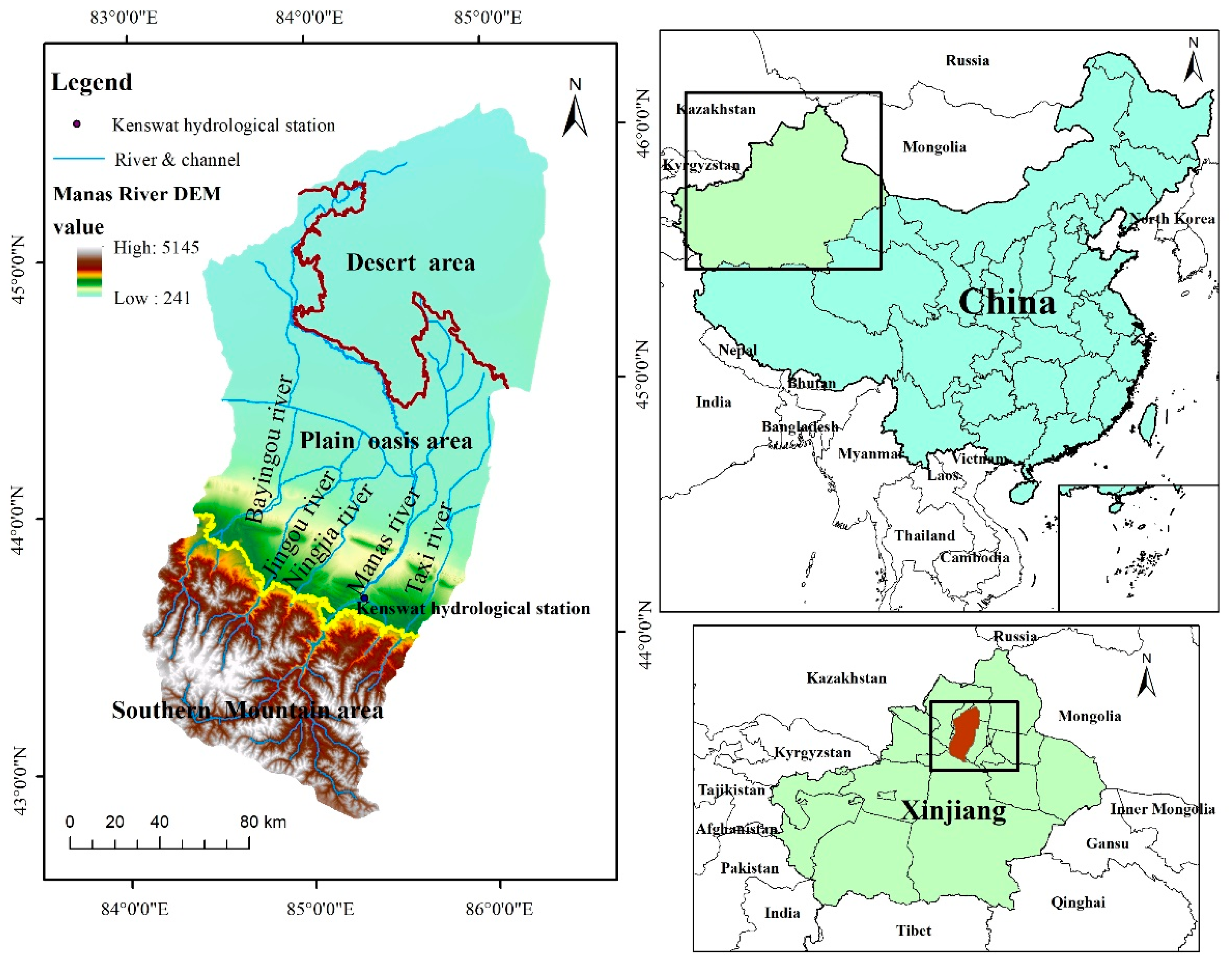
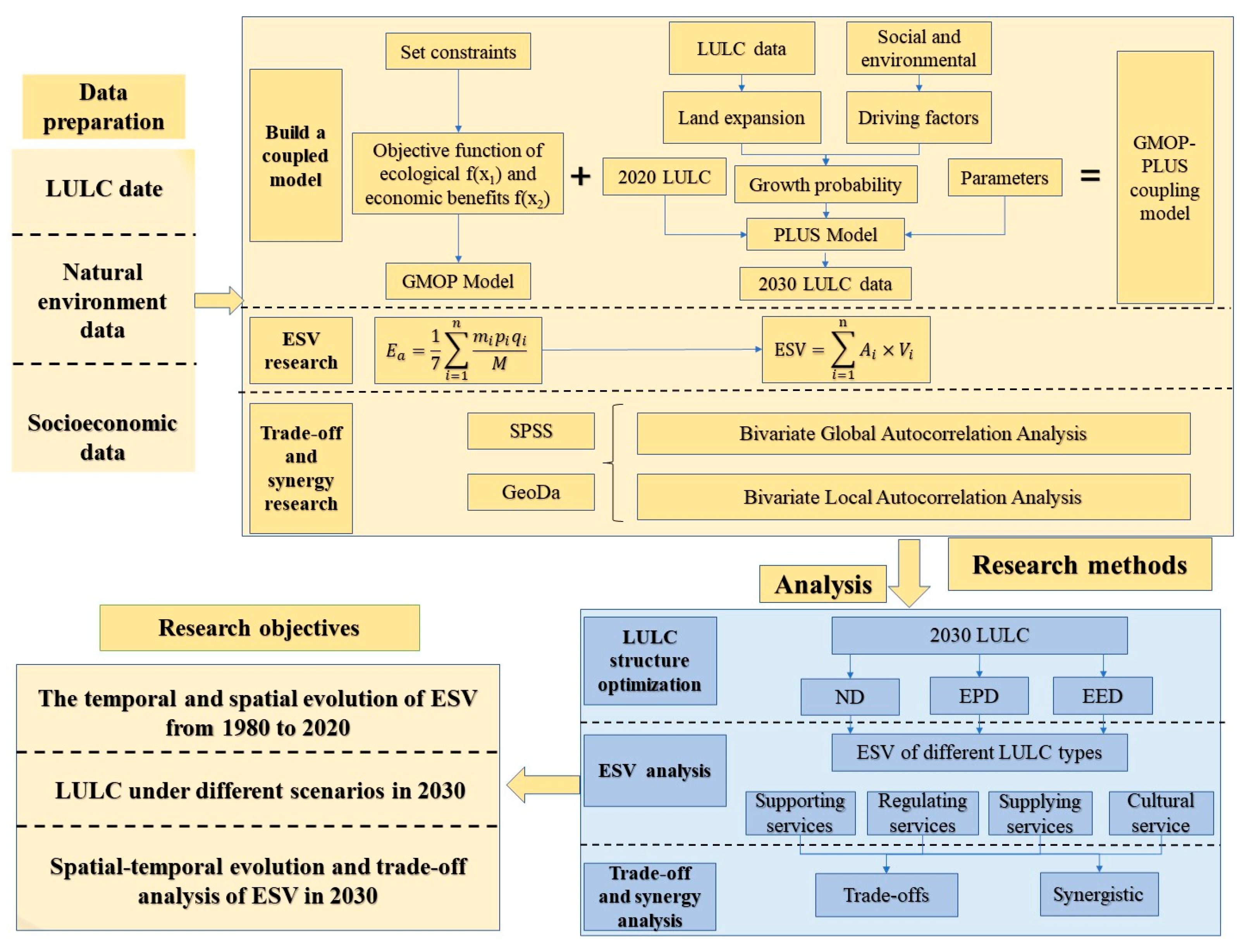
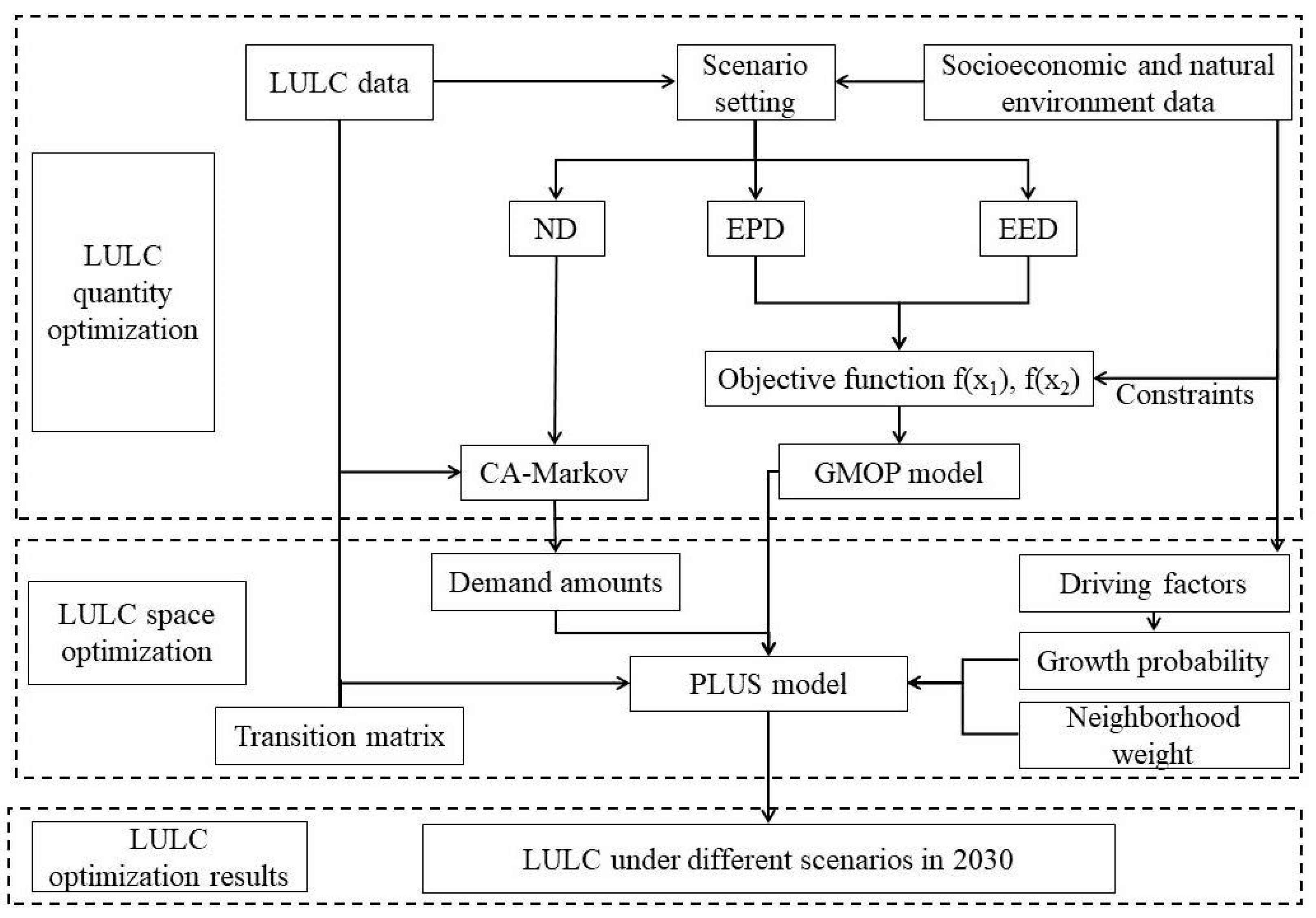
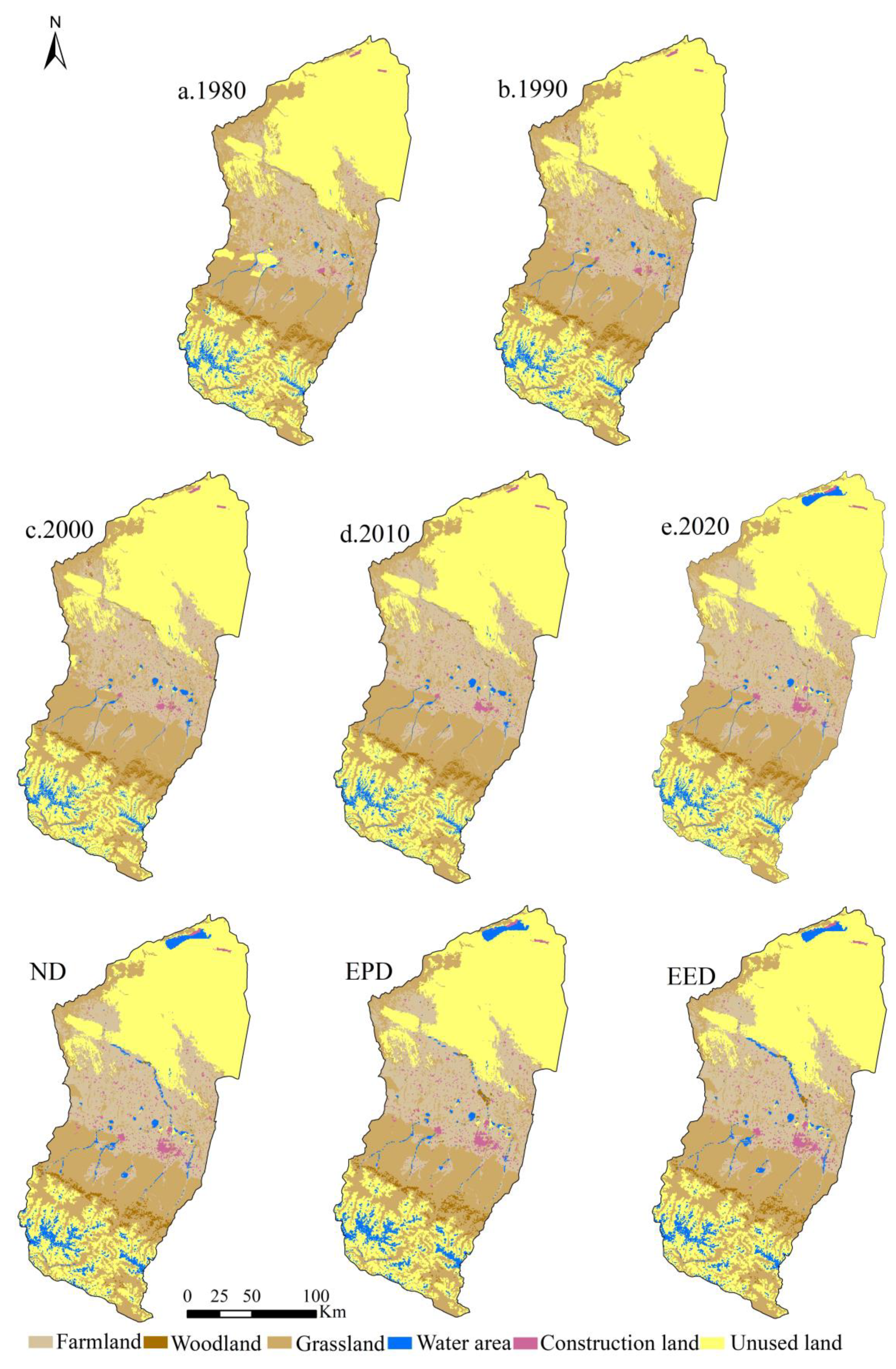
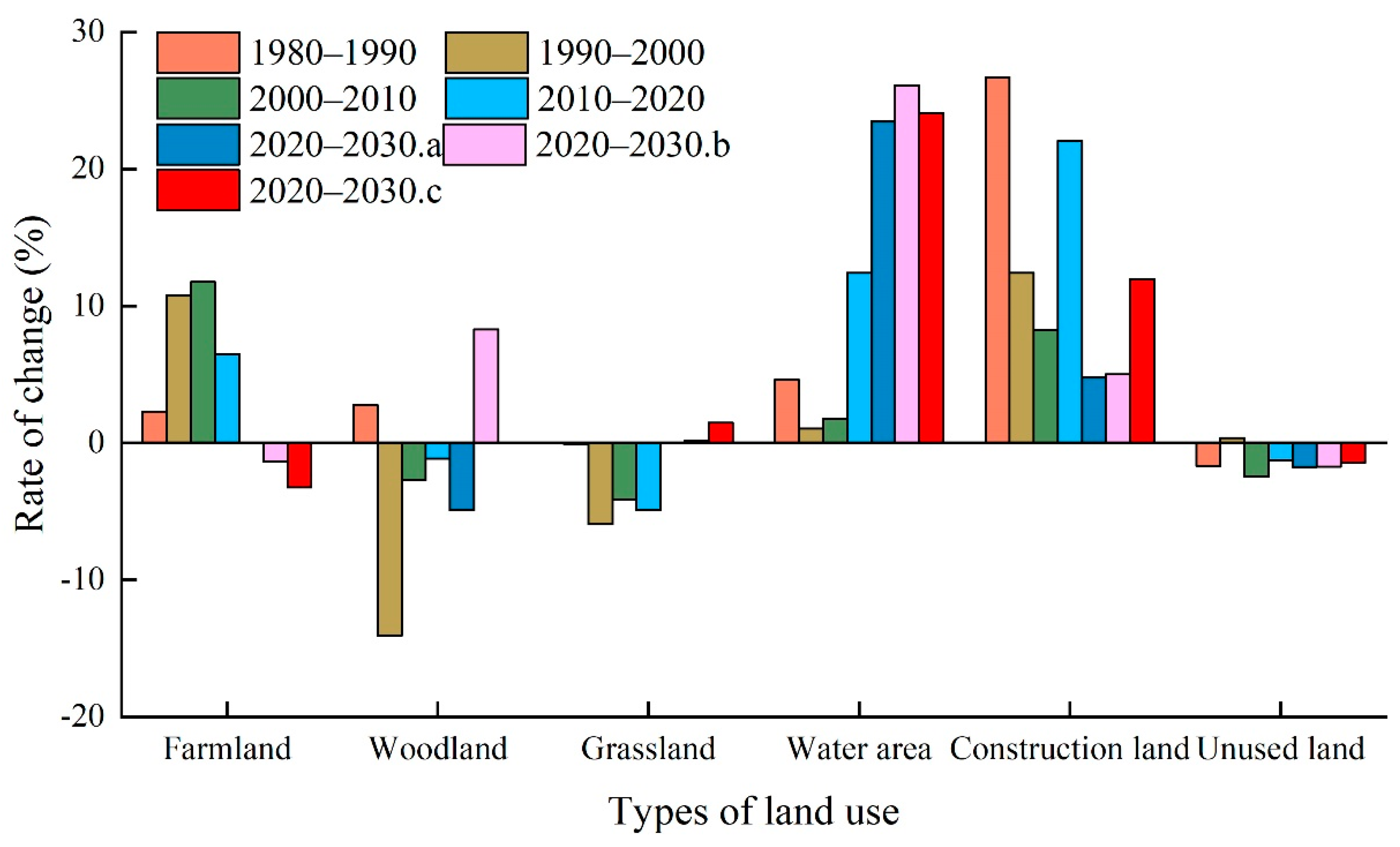


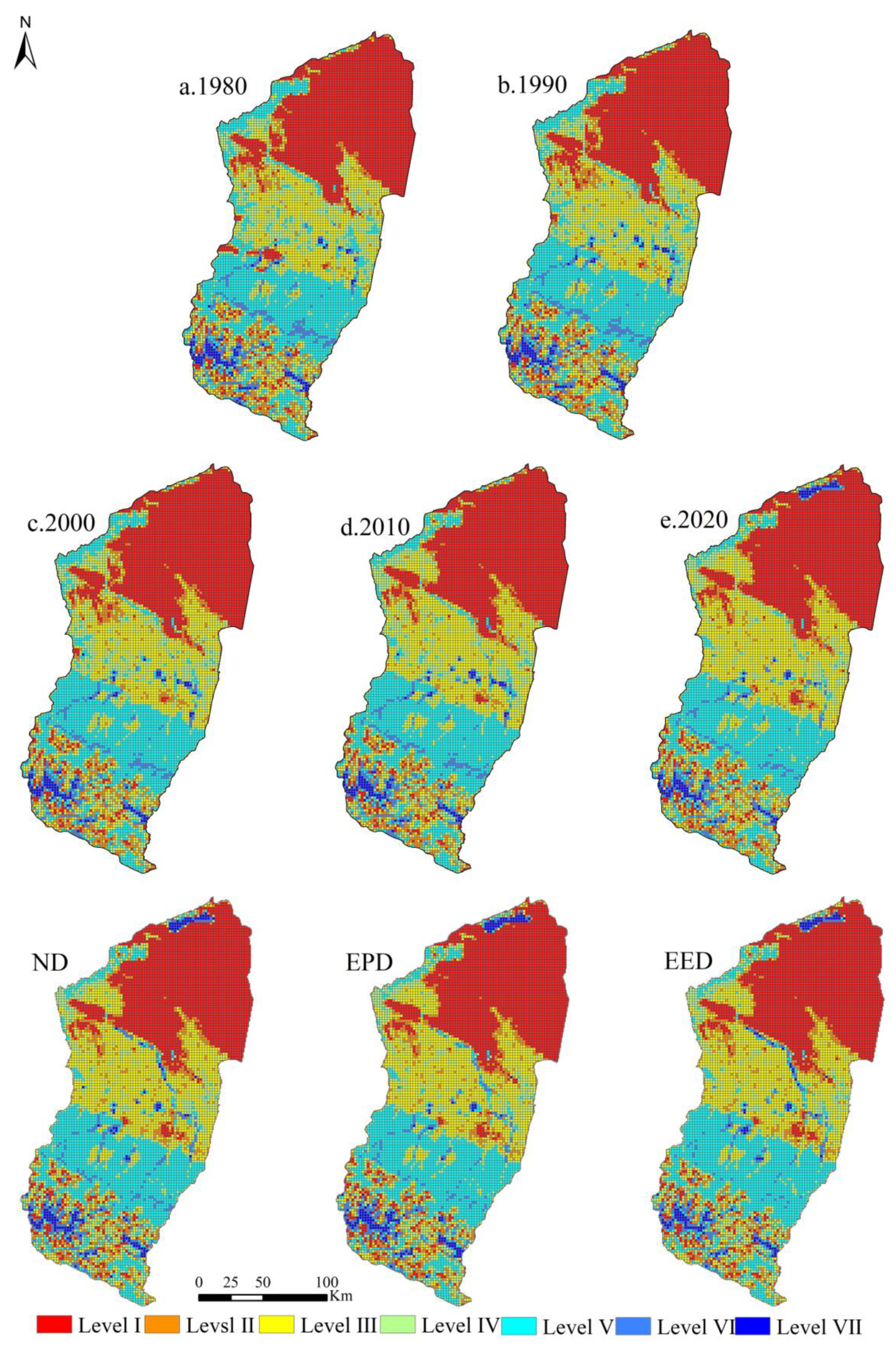
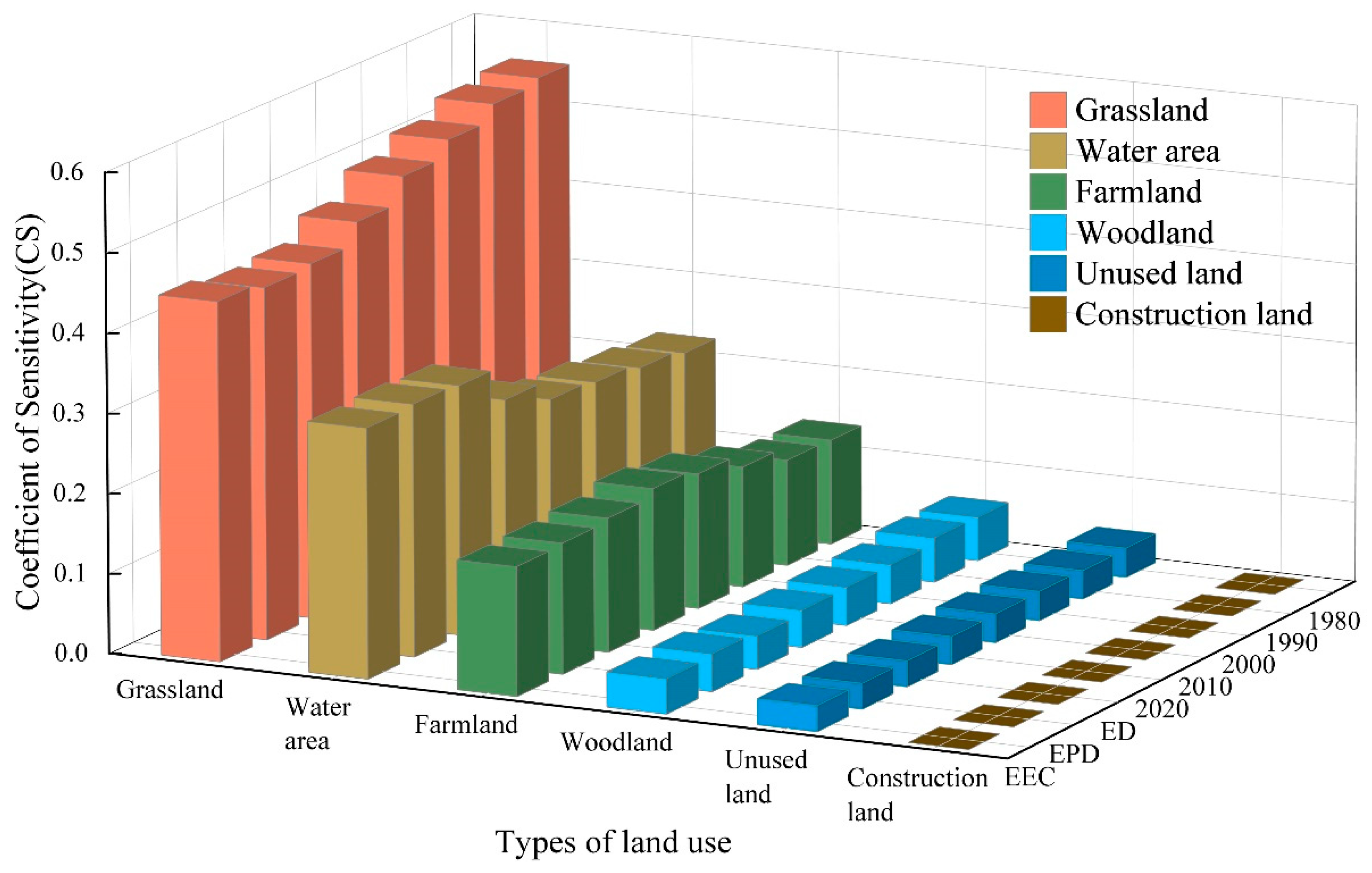
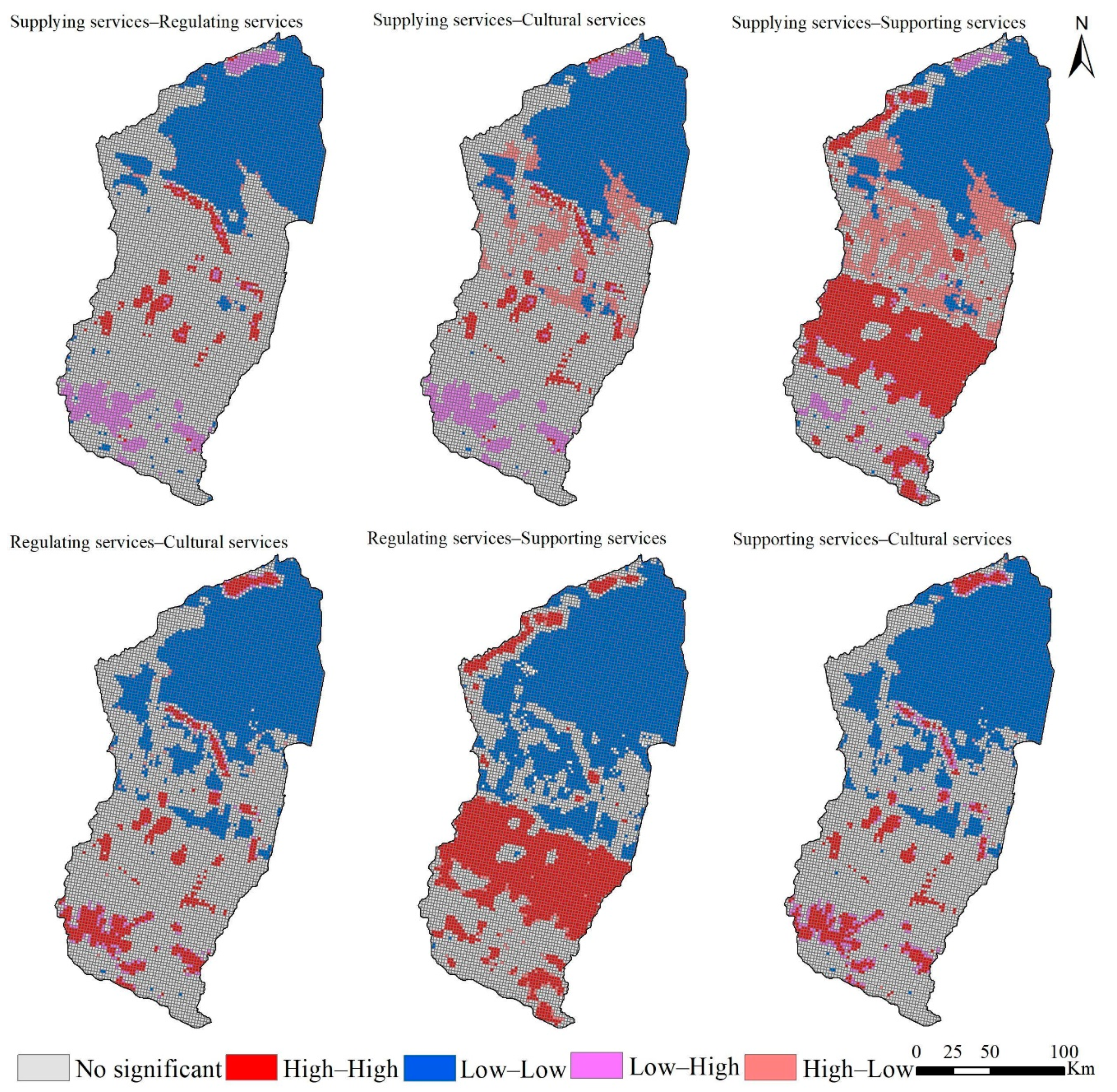
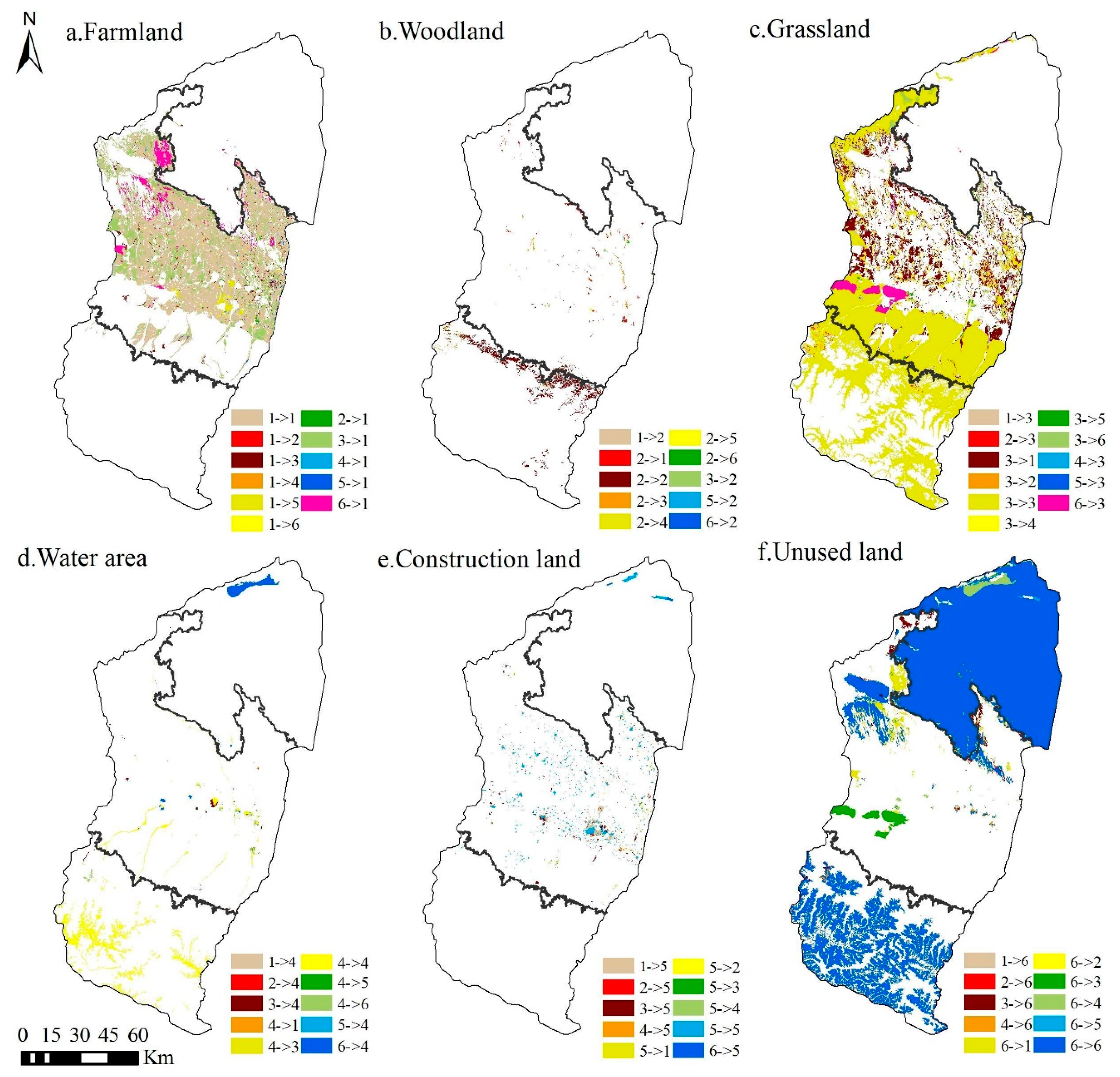
| Ecosystem Classification | Farmland | Woodland | Grassland | Water Area | Construction Land | Unused Land | |
|---|---|---|---|---|---|---|---|
| Supplying services | Food production | 650.35 | 112.13 | 257.9 | 224.26 | 0 | 11.21 |
| Raw material production | 100.92 | 2915.37 | 381.24 | 44.85 | 0 | 16.82 | |
| Regulating services | Gas conditioning | 1244.64 | 3924.53 | 1356.77 | 1009.17 | 0 | 11.21 |
| Climate regulation | 571.86 | 3027.5 | 3576.93 | 9844.97 | 0 | 78.49 | |
| Water conservation | 672.78 | 3588.14 | 897.04 | 20,116.02 | 0 | 33.64 | |
| Waste disposal | 1838.92 | 1468.9 | 1468.9 | 20,385.13 | 0 | 11.21 | |
| Supporting services | Soil formation and protection | 11.21 | 4373.05 | 1513.75 | 964.31 | 0 | 22.43 |
| Biodiversity | 235.47 | 3655.42 | 1502.53 | 2803.24 | 0 | 381.24 | |
| Cultural Services | Aesthetic landscape | 100.92 | 1435.26 | 661.56 | 5550.41 | 11.21 | 11.21 |
| Year | Farmland | Woodland | Grassland | Water Area | Construction Land | Unused Land |
|---|---|---|---|---|---|---|
| 1980 | 5786.59 | 536.29 | 11,281.16 | 867.08 | 288.43 | 15,291.96 |
| 1990 | 5919.35 | 551.09 | 11,271.38 | 907.11 | 365.42 | 15,037.16 |
| 2000 | 6557.07 | 473.64 | 10,601.43 | 916.78 | 410.77 | 15,091.80 |
| 2010 | 7328.37 | 460.77 | 10,162.20 | 933.06 | 444.59 | 14,722.51 |
| 2020 | 7804.49 | 455.52 | 9663.77 | 1048.93 | 542.70 | 14,536.10 |
| 2030.a | 7807.49 | 433.20 | 9666.02 | 1295.35 | 568.94 | 14,280.50 |
| 2030.b | 7700.22 | 493.29 | 9679.65 | 1322.70 | 569.96 | 14,285.70 |
| 2030.c | 7550.26 | 455.68 | 9807.96 | 1301.60 | 607.71 | 14,328.29 |
| Ecosystem Classification | 1980 | 1990 | 2000 | 2010 | 2020 | ND | EPD | EED | |
|---|---|---|---|---|---|---|---|---|---|
| Supplying service | Food production | 7.10 | 7.19 | 7.43 | 7.81 | 8.02 | 8.07 | 8.02 | 7.94 |
| Raw material production | 6.74 | 6.79 | 6.38 | 6.25 | 6.09 | 6.03 | 6.21 | 6.13 | |
| Regulating service | Gas conditioning | 25.66 | 25.91 | 25.50 | 25.82 | 25.83 | 26.00 | 26.15 | 25.97 |
| Climate regulation | 55.02 | 55.48 | 53.31 | 52.28 | 51.88 | 54.22 | 54.66 | 54.72 | |
| Water conservation | 33.89 | 34.82 | 34.57 | 34.96 | 37.14 | 42.02 | 42.72 | 42.18 | |
| Waste disposal | 45.85 | 46.91 | 47.18 | 48.27 | 50.76 | 55.76 | 56.23 | 55.65 | |
| Supporting service | Soil formation and protection | 20.67 | 20.75 | 19.42 | 18.71 | 18.05 | 18.18 | 18.49 | 18.50 |
| Biodiversity | 28.53 | 28.62 | 27.53 | 26.91 | 26.51 | 27.02 | 27.31 | 27.29 | |
| Cultural service | Aesthetic landscape | 13.80 | 14.05 | 13.62 | 13.47 | 13.83 | 15.16 | 15.40 | 15.30 |
| Ecosystem Services | Pearson Coefficient | Moran’s I | ||||
|---|---|---|---|---|---|---|
| ND | EPD | EED | ND | EPD | EED | |
| Supplying services–Regulating services | 0.243 | 0.256 | 0.261 | 0.19 | 0.206 | 0.214 |
| Supplying services–Supporting services | 0.606 | 0.597 | 0.609 | 0.466 | 0.468 | 0.474 |
| Supplying services–Culture services | 0.142 | 0.15 | 0.157 | 0.097 | 0.11 | 0.119 |
| Regulating services–Supporting services | 0.55 | 0.547 | 0.551 | 0.385 | 0.38 | 0.38 |
| Regulating services–Culture services | 0.987 | 0.986 | 0.986 | 0.637 | 0.621 | 0.614 |
| Supporting services–Culture services | 0.563 | 0.562 | 0.563 | 0.395 | 0.394 | 0.389 |
Publisher’s Note: MDPI stays neutral with regard to jurisdictional claims in published maps and institutional affiliations. |
© 2022 by the authors. Licensee MDPI, Basel, Switzerland. This article is an open access article distributed under the terms and conditions of the Creative Commons Attribution (CC BY) license (https://creativecommons.org/licenses/by/4.0/).
Share and Cite
Du, Y.; Li, X.; He, X.; Li, X.; Yang, G.; Li, D.; Xu, W.; Qiao, X.; Li, C.; Sui, L. Multi-Scenario Simulation and Trade-Off Analysis of Ecological Service Value in the Manas River Basin Based on Land Use Optimization in China. Int. J. Environ. Res. Public Health 2022, 19, 6216. https://doi.org/10.3390/ijerph19106216
Du Y, Li X, He X, Li X, Yang G, Li D, Xu W, Qiao X, Li C, Sui L. Multi-Scenario Simulation and Trade-Off Analysis of Ecological Service Value in the Manas River Basin Based on Land Use Optimization in China. International Journal of Environmental Research and Public Health. 2022; 19(10):6216. https://doi.org/10.3390/ijerph19106216
Chicago/Turabian StyleDu, Yongjun, Xiaolong Li, Xinlin He, Xiaoqian Li, Guang Yang, Dongbo Li, Wenhe Xu, Xiang Qiao, Chen Li, and Lu Sui. 2022. "Multi-Scenario Simulation and Trade-Off Analysis of Ecological Service Value in the Manas River Basin Based on Land Use Optimization in China" International Journal of Environmental Research and Public Health 19, no. 10: 6216. https://doi.org/10.3390/ijerph19106216
APA StyleDu, Y., Li, X., He, X., Li, X., Yang, G., Li, D., Xu, W., Qiao, X., Li, C., & Sui, L. (2022). Multi-Scenario Simulation and Trade-Off Analysis of Ecological Service Value in the Manas River Basin Based on Land Use Optimization in China. International Journal of Environmental Research and Public Health, 19(10), 6216. https://doi.org/10.3390/ijerph19106216







